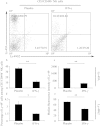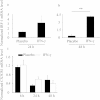IFN-γ modulates Ly-49 receptors on NK cells in IFN-γ-induced pregnancy failure
- PMID: 26655673
- PMCID: PMC4676035
- DOI: 10.1038/srep18159
IFN-γ modulates Ly-49 receptors on NK cells in IFN-γ-induced pregnancy failure
Abstract
We have previously shown that interferon gamma (IFN-γ) induces aberrant CD49b(+) natural killer (NK) cell recruitment by regulating CX3CL1 and eventually provokes foetal loss. In this study, we show that IFN-γ also modulates Ly-49 receptors on NK cells during pregnancy failure. The percentages of Ly-49A(+) and Ly-49G2(+) NK cells in the uteri of the IFN-γ-treated group were significantly lower than those observed in the control group. Moreover, the median fluorescence intensity (MFI) values of Ly-49A and Ly-49G2 expression on NK cells in the uteri of the IFN-γ-treated group were significantly lower than those of the control group. Using isolated spleen leucocytes, we further found that IFN-γ significantly reduced the percentage of Ly-49A(+) NK cells in vitro. However, CX3CL1 was not involved in the modulation of Ly-49 receptors, and the expression of CX3CR1 was not regulated by IFN-γ in spleen leucocytes. Collectively, our data indicate that IFN-γ can modulate Ly-49 receptors on NK cells and this process may play a role in IFN-γ-induced pregnancy failure. Thus, we provide a new line of evidence correlating the deleterious effects of IFN-γ with its role in regulating NK cell Ly-49 receptors during pregnancy failure.
Figures





References
-
- Di Santo J. P. Natural killer cell developmental pathways: a question of balance. Annu Rev Immunol 24, 257–286 (2006). - PubMed
-
- Lanier L. L. NK cell recognition. Annu Rev Immunol 23, 225–274 (2005). - PubMed
-
- Lanier L. L. NK cell receptors. Annu Rev Immunol 16, 359–393 (1998). - PubMed
-
- Orr M. T. & Lanier L. L. Inhibitory Ly49 receptors on mouse natural killer cells. Curr Top Microbiol Immunol 350, 67–87 (2011). - PubMed
-
- Dissen E., Fossum S., Hoelsbrekken S. E. & Saether P. C. NK cell receptors in rodents and cattle. Semin Immunol 20, 369–375 (2008). - PubMed
Publication types
MeSH terms
Substances
LinkOut - more resources
Full Text Sources
Other Literature Sources
Research Materials
Miscellaneous

